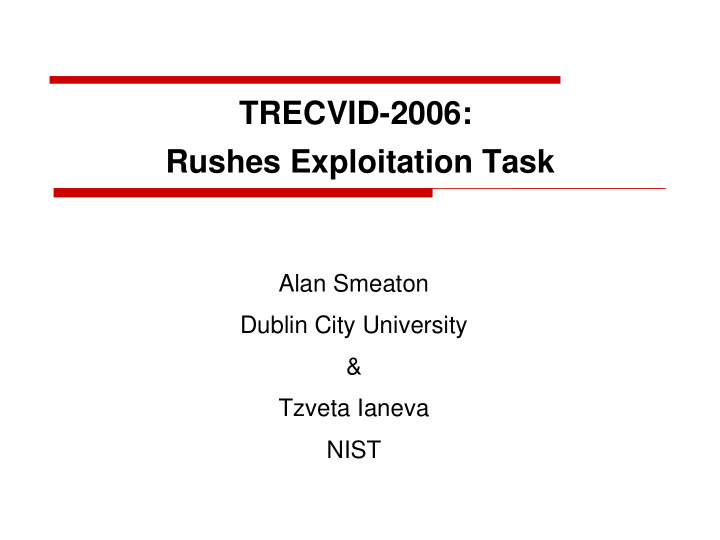



TRECVID-2006: Rushes Exploitation Task Alan Smeaton Dublin City University & Tzveta Ianeva NIST
Rushes Exploitation Task Definition Goal: research about the feasibility of shifting to work on unproduced video; Develop a toolkit for support of exploratory search on highly redundant rushes data Summarize -- remove/hide redundancy of as many kinds as possible Organize – present non-redundant material according to at least 6 not all cinematographic or camera setting features, well motivated from some user/task context point of view Develop an evaluation scheme TRECVID 2006 2
Rushes Exploitation Task Definition Innovation in approaches – no standard keyframes or shot boundaries provided Evaluation and presentation of results by participants Data: 50 hours of rushes provided by BBC Archive French experience, travel videos and interviews Video example TRECVID 2006 3
2006: Rushes exploitation task participants Accenture Technology Labs USA AT&T Labs – Research USA Chinese Academy of Sciences (CAS/MCG) China Curtin U. of Technology Australia DFKI GmbH Germany U. Rey Juan Carlos/ Dublin City U. Spain/Ireland IBM T. J. Watson Research Center USA Institut EURECOM France Joanneum Research Forschungsgesellschaft mbH Austria Tsinghua U. China U. of Marburg Germany COST292 (www.cost292.org) Fr, Neth, UK, Irl, Gr, Turk, Serbia &Mont. Slovakia Accenture & COST292 have speaker slots to follow TRECVID 2006 4
AT&T Labs - Research Collaboration w/ Columbia U.; Motion-based shot segmentation (cf. Tsinghua); Large (374) set of LSCOM HLFs on resulting shots; Computed image (KF ?) distances within each video file; Annotation into 1 of 15 audio classes, (speech/non, male/female, range of low-level audio features); Speaker segmentation; Browsing interface built; TRECVID 2006 5
Chinese Academy of Sciences (CAS/MCG) Apply a range of concept feature identification to audio and visual … face, interview, person, etc. Some SVM classifiers used (LSCOM ?) Camera motion infers intention; Hierarchical browsing to address redundancy and repetition; Interface for filter/browse is built; TRECVID 2006 6
Curtain U of Technology Not sure what they did, paper outside, no time to read yet ! TRECVID 2006 7
DFKI No paper Fast motion-based features w/ spatial aspects Clustering TRECVID 2006 8
U. Rey Juan Carlos A kind of shot bound detection .. detecting substantial differences as “events”; User filtering of useless shots … eg calibration of camera; Apply 39 SVMs from DCU feature submission; Build interface to filter and browse keyframes; Collaboration w/ DCU TRECVID 2006 9
IBM T.J. Watson No details except an exploration of semantic concept models from B/news to rushes, exploring feature-based and semantic-based clustering; TRECVID 2006 10
Institut Eurecom Perform SBD then remove inter- and intra-shot redundancy by similarity and then hierarchical clustering; User search based on visual dictionary - cluster rushes keyframes into groups, these groups form ‘words’ in the dictionary; Proposed evaluation through simulated user experiments TRECVID 2006 11
Joanneum Research Pictorial summary, allowing browsing, ordering and annotation of video; Used camera motion, motion intensity, global and local visual similarity, audio volume, facesand object re-detection … all to generate a pictorial summary of video file; Performed some user tests and evaluation … 7 uses, 4 search tasks; TRECVID 2006 12
Tsinghua University Similar to URJC using motion and SBD to yield KFs, and then ran some hierarchical clustering to remove redundancy, then some HLFs on the remainder. TRECVID 2006 13
Univ. Marburg Again, unsupervised clustering of shots to eliminate redundant shots; Additionally, the following features can be used to “slide and dice” - camera motion, faces, shot lengths, audio information, interviews, … 13 in total; Interactive browsing tool developed and evaluated in-house; TRECVID 2006 14
Observations A good number of groups can build systems to ingest, analyze, and allow user filtering and summarization; Most redundancy detected through clustering; Surprising emphasis on audio classification; Few groups did actual evaluation … those that did did classic ad hoc search; TRECVID 2006 15
Recommend
More recommend